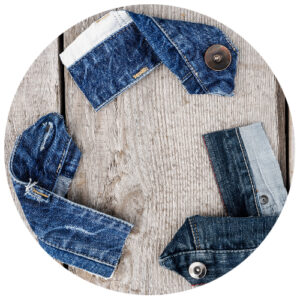Following in the footsteps of food; how fashion must turn to sustainability to survive the fall of the high street.
The high street is changing. Many familiar brands that we know and love are leaving us. The reasons are well publicised. Traditional bricks and mortar brands are now facing too much competition from a multitude of new, online players. People now want to be able to shop around at the touch of a button; high street brand loyalty has reduced, people want to find cheaper options and be able to order to their door.
Building a dominant online presence at this point is also extremely difficult given the competition. Brands such as Boohoo and Net-a-Porter have nailed the online market and are able to release new ranges and collections at a staggering rate, leaving little room for new or slow-to-market brands. For those that haven’t made a push for a heavy online presence with a great digital customer experience, it is now almost too late to catch up.
Another reason is that the costs of maintaining high street stores are rising to an unprecedented and unsustainable level. The National Minimum Wage and National Living Wage rise each year, as do Business Rates and rental costs. With these rises in cost, along with the high number of stores many brands hold across the UK, it is becoming extremely difficult to sustain underperforming or superfluous outlets.
SO HOW DO RETAILERS SURVIVE?
If ‘moving online’ was the trend of the past decade, going ‘green’ must be the trend of this season.
Fashion is now a $3 trillion-dollar industry*, and this number is expected to rise year-on-year. With that, we’ve seen a major trend towards ‘fast fashion’; the desire to make new fashion trends available to consumers much more quickly, at often lower prices.
As the desire for fast fashion grows, so does the number of items being produced and bought. From 2000 to 2014, the number of garments purchased each year by the average consumer increased by 60%, with shoppers keeping their clothes about half as long as 15 years ago**. Many well-known high street brands push out new ranges every month at extremely low prices. This means more efficient and low-cost supply chains, reducing the quality. The result? According to the Council for Textile Recycling, the United States produces 25 billion pounds of clothing waste every single year and in the EU, only 18% of clothing is currently reused or recycled.
At the other end of the high-street, luxury brands have also been known to destroy unsold clothes, accessories and perfume to protect the status of their brand.
THE DRIVE FOR ETHICAL SUPPLY
Waste isn’t the only reason there is a desire to make fashion go green. It is also a question of ethics around the supply chain; both in terms of the process of making goods and the condition for workers in the industry. Firstly, making clothes typically requires using a lot of water, many use toxic chemicals in their supply chain and the whole process emits significant amounts of greenhouse gases. Secondly, workers in clothing-factories are largely underpaid, child labour is prevalent, and workers can be exposed to extremely unsafe conditions.
Given all the above, it is easy to see why the fashion industry needs to follow in the footsteps of the food industry and move towards a more sustainable model.
FASHION GOES GREEN
The last couple of years has seen a seismic shift towards sustainability in food. More people have become vegan and vegetarian than ever. In 2015 an introduction of a 5p charge was introduced for plastic shopping bags, resulting in an 86% reduction in plastic bag use in large supermarkets. Plastic straws, stirrers and cotton buds are all following suit. The trend to go green in the food industry has really stuck and fashion is next.
The following new trends in fashion, focusing on sustainability and purpose could reinvigorate the retail industry and allow brands to survive in the harsh climate of the high street.
- Sustainable material
The first is the shift to sustainable materials such as recycled wool or Lyocell, which is biodegradable. Another example is “better cotton”; cotton grown under the Better Cotton Initiative (BCI). The BCI promotes better standards in cotton farming and aims to eliminate harmful pesticides and encourage strict water management.
Retailers need to think about how they could introduce these materials in to their supply chains and analyse the potential additional costs of sourcing these versus the benefit.
- Recycled material
We are also seeing a growth in the number of new companies using exclusively recycled materials in their supply chain. One example, Elvis & Cresse, a London based accessories brand, produces luxury products out of waste material. In 2017 they made a deal to use around 120 tonnes of leather offcuts from Burberry for their products.
There are now also numerous other new entrants making clothing, jewellery, accessories and home-wear from recycled and sustainable products and there has been an increase in mainstream press interest in these brands.
Given the rising status of these brands, new entrants should consider their strategy up-front as well as the risk of not conforming.
- High quality and long lasting
The industry is starting to move away from fast fashion to making durable, quality pieces that last. There is also a resurgence of more ‘timeless’ pieces in collections. This can be seen in brands such as Ralph Lauren and Levi’s. There are certain brands that will even mend your items or will allow you to send them back no matter when you bought them to ensure the lifecycle of the product lasts much longer.
To do this, retailers will need to consider their operating model and whether costs may need to be reduced elsewhere.
- Brands with a purpose
As with the modern vegetarian movement, people are now taking more time to think about the brands they buy. They want to see brands with a purpose such as shoe brands Toms and Gandys: what do they represent and what charities do they support. Brands need to consider their values and strategy to consider how they might be able to give back.
Once a brand has committed to an ethical strategy, it needs to consider the long-term risks and actions associated with this. An inability to follow through would result in negative PR, so a robust governance structure should be put in place to ensure the values or targets are being met.
- Ethical supply chain
Lastly but maybe most importantly, reviewing supply chains is now more significant than ever. Brands need to be able to vouch that the materials themselves and the environment from which they source their material is ethical and safe for their workers, and workers are paid a fair wage.
This means brands need to review their end to end business model to be able to move towards sustainable materials, a fair working environment and supply chain.
LEADERS OF THE PACK
As well as the new, ethical entrants to the market that only sell recycled clothing, some more-established brands are making leaps and bounds with much of the above. One example is Burberry. The company is a core partner of the Make Fashion Circular initiative from the Ellen MacArthur Foundation, a project to create business models which will keep garments in use, utilise materials which are renewable and find ways of recycling old clothes into new products.***
Recent press has announced the firm will no longer be destroying waste, with the newly appointed CEO, Marco Gobetti, going so far as to say that sustainability is intrinsically linked to the success of the business: “Modern luxury means being socially and environmentally responsible…This belief is core to us at Burberry and key to our long-term success.”****
One blocker to this move towards sustainability in retail will be the constant tension in shopper’s minds for fast and affordable fashion. Some of those most famous brands for this trend have seen recent sales and profits increase, with consumers continuing to shop there despite negativity surrounding their supply chains.
But how long can that really last? With increasing options for sustainable and recyclable material at our fingertips, brands need to consider how they can start to incorporate these in to their products. Brands must also consider the increasingly morally conscious customer that wants to see brands with a purpose and an ethical supply chain. Our advice would be that retailers need to review their strategy and business models to ensure they stay ahead of this new green trend. It is certain to be at the forefront of seasons to come.
* Global fashion industry statistics | Fashion United
** Style that’s sustainable | McKinsey & Company
*** The burning question | Edie.net
**** Burberry stops burning goods and using real fur | BBC
Visit the Gate One member page

